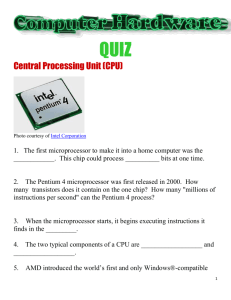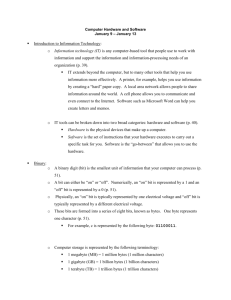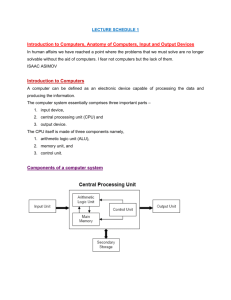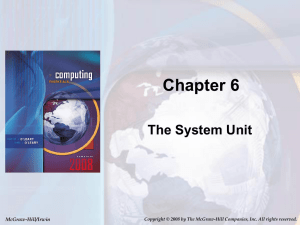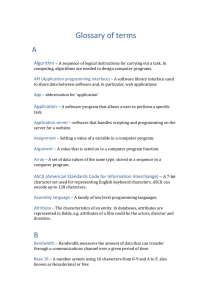Chapter 3
advertisement
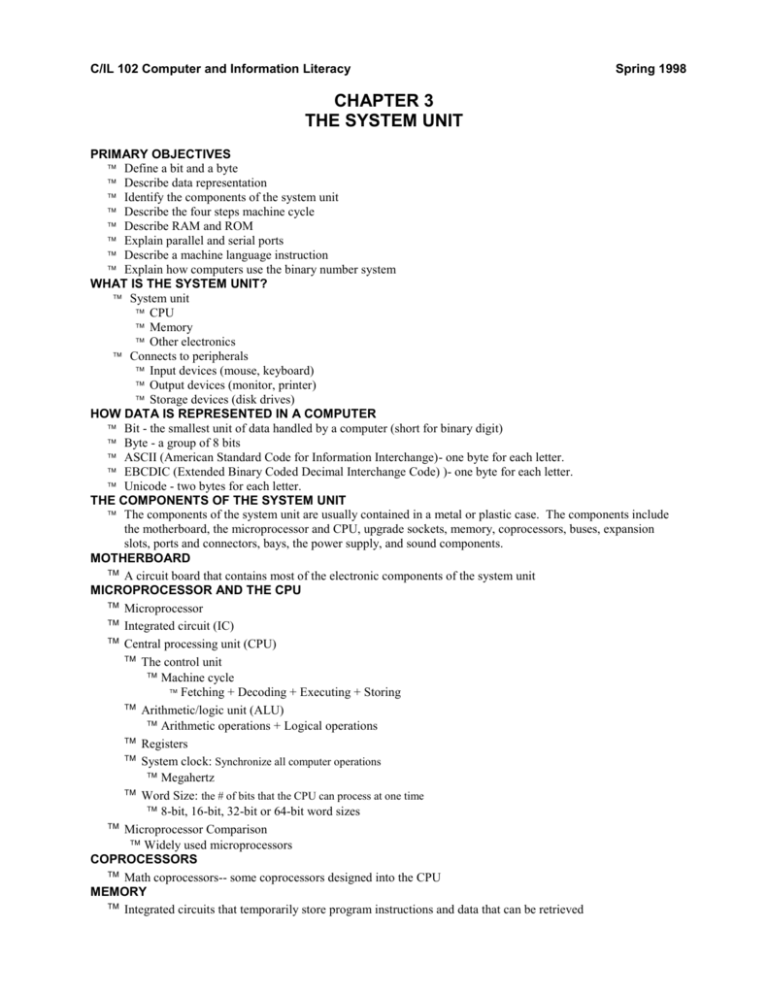
C/IL 102 Computer and Information Literacy Spring 1998 CHAPTER 3 THE SYSTEM UNIT PRIMARY OBJECTIVES Define a bit and a byte Describe data representation Identify the components of the system unit Describe the four steps machine cycle Describe RAM and ROM Explain parallel and serial ports Describe a machine language instruction Explain how computers use the binary number system WHAT IS THE SYSTEM UNIT? System unit CPU Memory Other electronics Connects to peripherals Input devices (mouse, keyboard) Output devices (monitor, printer) Storage devices (disk drives) HOW DATA IS REPRESENTED IN A COMPUTER Bit - the smallest unit of data handled by a computer (short for binary digit) Byte - a group of 8 bits ASCII (American Standard Code for Information Interchange)- one byte for each letter. EBCDIC (Extended Binary Coded Decimal Interchange Code) )- one byte for each letter. Unicode - two bytes for each letter. THE COMPONENTS OF THE SYSTEM UNIT The components of the system unit are usually contained in a metal or plastic case. The components include the motherboard, the microprocessor and CPU, upgrade sockets, memory, coprocessors, buses, expansion slots, ports and connectors, bays, the power supply, and sound components. MOTHERBOARD A circuit board that contains most of the electronic components of the system unit MICROPROCESSOR AND THE CPU Microprocessor Integrated circuit (IC) Central processing unit (CPU) The control unit Machine cycle Fetching + Decoding + Executing + Storing Arithmetic/logic unit (ALU) Arithmetic operations + Logical operations Registers System clock: Synchronize all computer operations Megahertz Word Size: the # of bits that the CPU can process at one time 8-bit, 16-bit, 32-bit or 64-bit word sizes Microprocessor Comparison Widely used microprocessors COPROCESSORS Math coprocessors-- some coprocessors designed into the CPU MEMORY Integrated circuits that temporarily store program instructions and data that can be retrieved C/IL 102 Computer and Information Literacy Memory address Size Kilobyte (K or KB) = 1,024 bytes Megabyte (MB) = 1 thousand kilobytes Gigabyte (GB) = 1 million kilobytes COMMON MEMORY TYPES RAM (random access memory) Volatile Flash RAM SIMMs and DIMMs Cache Level 1 (L1) - internal cache on the chip itself Level 2 (L2) - cache on the motherboard or the CPU ROM (read only memory) Stores information or instructions that do not change nonvolatile Instructions stored here are called firmware or microcode CMOS (complementary metal-oxide semiconductor) Stores information about the system, such as amount of RAM and the keyboard type Used when the computer starts up Battery powered MEMORY SPEED Access time -- The time needed to find and retrieve data Dynamic RAM (DRAM) -- 50 - 100 ns (Nanoseconds -- one billionth of a second) Static RAM (SRAM) -- 10-50 ns BUSES Path along which bits are transmitted Local bus -- connected to the CPU directly Expansion bus -- connected to the memory EXPANSION SLOTS Expansion card Expansion board/Controller card/Adapter card/Interface card PC Card PCMCIA cards (Personal Computer Memory Card International Association) PORTS AND CONNECTORS Used to connect the system unit to peripheral devices, such as printers and modems Connectors Male + Female Parallel ports Printers / Disk and tape drives / SCSI (small computer system interface) Serial ports Mouse / Keyboard / MIDI MACHINE LANGUAGE INSTRUCTIONS Instruction set Instruction = Operation code + Operands MIPS: Million instructions per second Floating point operations Megaflops (MFLOPS) / Gigaflops (GFLOPS) NUMBER SYSTEMS Decimal number system Base 10 number system Spring 1998 C/IL 102 Computer and Information Literacy Binary number system Base 2 number system Hexadecimal number system Base 16 number system Converting ASCII to hexadecimal Spring 1998


